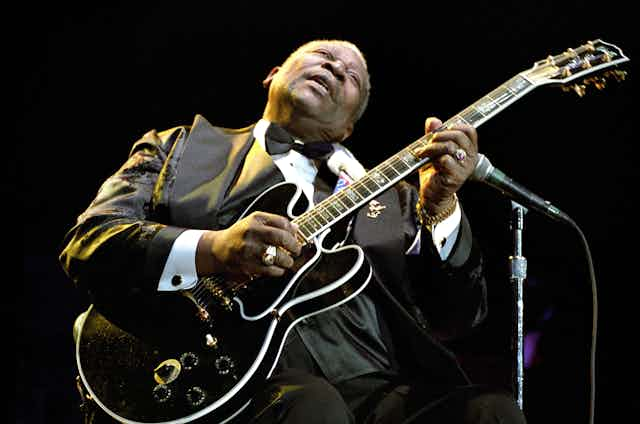Following months of rumours, Gibson, the legendary guitar manufacturer, has filed for bankruptcy with debts of between US$100m and US$500m. More significantly, the company also announced plans to reorganise and restructure its business, saying it has agreements with holders of more than 69% of its debt that would allow it to continue to operate. To me, this is the real story here and it speaks volumes.
When the opportunity arose to write this article, I was asked what my angle would be. My initial response was: “Quite simply, Gibson is the sound of rock.” But it’s so much more than that. The warm tones of the 335, one of their earliest electric guitars, dominates jazz and blues music. BB King was a lifelong player – his famous guitar “Lucille” is still a popular signature series instrument.
And when Reggae pioneer Bob Marley first appeared on Top of the Pops he was playing a Les Paul Special, a guitar he was to become forever associated with, its offbeat choppy attack helping define the genre.
What’s your rig?
In truth, Gibson guitars have played a major part in defining the sound of popular music. In the popular YouTube documentary series, Rig Rundown, famous guitarists and their technicians discuss the minutiae of complex guitar effects systems, unusual string gauges and the range of different amplifiers used to create their signature sound. In the programme that focuses on AC/DC, the secret to one of the world’s most iconic guitar tones is finally – almost disappointingly – revealed. Standard edition Gibson SG guitar, cable and amp. It’s that simple.
Rock music wouldn’t be the same without the Gibson. Picture Chuck Berry with his zoot suit and quiff, duck-walking across the stage mid-solo – or Jimmy Page at the peak of his powers, attacking his instrument with a violin bow while a spellbound Madison Square Garden crowd looks on.
Consider the twin horned attack of Angus Young as he lies, spot lit and centre stage, legs spasming, turning in endless circles with his guitar screaming; or Slash, pretty much at any point in his 30-year career, top hat and hair, cigarette dangling from his lips and a low-slung guitar dangling from his shoulder. Central to all of these is the Gibson guitar.
The guitars are also beautiful. We see them in shop window displays, hanging on people’s walls, some never to be played but their mere presence making the space just that bit edgier and cooler. One of my earliest memories is walking to nursery school, a route which took me past a music shop. From first sight, I was mesmerised. The shop spotlights catching the warm sunburst glow of a line of Les Pauls, the intricate grain of the wood clearly visible, shining hardware, lethal looking strings – each instrument different, yet also strikingly familiar.

Rise of a rock'n'roll classic
Orville Gibson founded the company in 1902 as the Gibson Mandolin-Guitar Mfg. Co Ltd in the wonderfully named Kalamazoo, Michigan. The company initially made mandolins and other similar instruments – but, as the business developed, so did Gibson. First they invented “archtop” guitars, which mimicked the shape of the violin, then by the 1930s the more familiar “flat top” acoustic guitars that we see today. The release of the Gibson Les Paul in 1952 cemented the company’s reputation as a builder of top class instruments. To date, this is still their most successful guitar.
If you’ve ever held a Gibson guitar, you can feel the history. Hollow body models feel fragile, almost insubstantial, seemingly poorly equipped to cope with the rigours of modern music performance. Solid body guitars feel like they’ve been knocked together in someone’s garage from spare offcuts of wood – the switches and knobs quaint 1950s artefacts. The first Les Paul was fashioned from a single four-foot wooden board and was affectionately known as The Log. A modern Les Paul is really not much different. They are heavy, in both senses of the word.
Perhaps part of Gibson’s problem has been that the instruments are truly cherished by the people who play them. Most of the original guitars from the 1950s, 1960s and 1970s are still in service, many commanding extraordinary sums of money on the secondhand market. Provenance adds further desirability and further value. Keith Richard’s 1959 Les Paul Standard, played on the Rolling Stones’ first US TV appearance on the Ed Sullivan Show, made history when it sold for US$1m back in 2003. Not bad for a piece of wood and a few bits of metal.
There has also been some speculation in the media that Gibson’s bankruptcy is to do with the decline of guitar bands, that we no longer have guitar heroes. But then look at the roster of artists currently dominating festival headline slots: Foo Fighters, Radiohead, Ed Sheeran, Fall Out Boy, Kings of Leon, Courteeners, The Vaccines, Biffy Clyro – and, guess what – the guitar, that six-stringed wonder, is central to each one of these artists’ sounds.
Gibson is an iconic brand, intrinsically linked with one of the greatest art forms of all time. Their guitars have played a hugely significant role in defining the sound of popular music, music which soundtracks the most important moments of our lives. Long may they continue to build these instruments. I have no doubt that they will.

